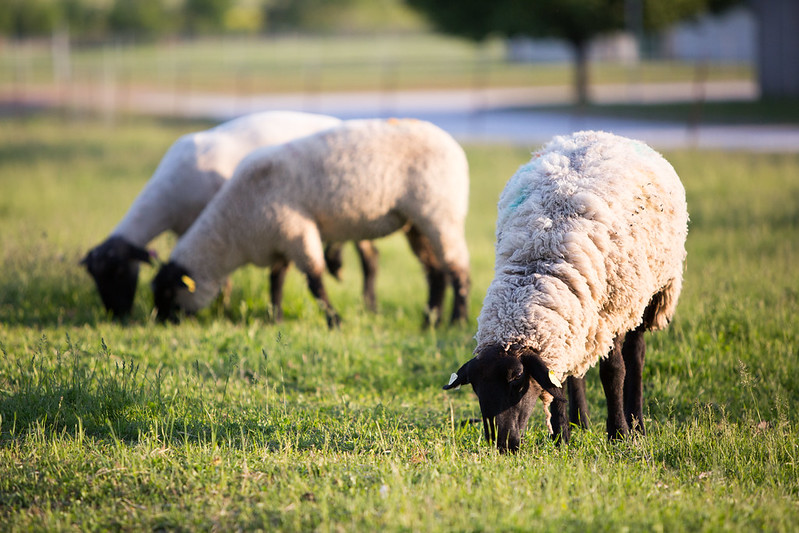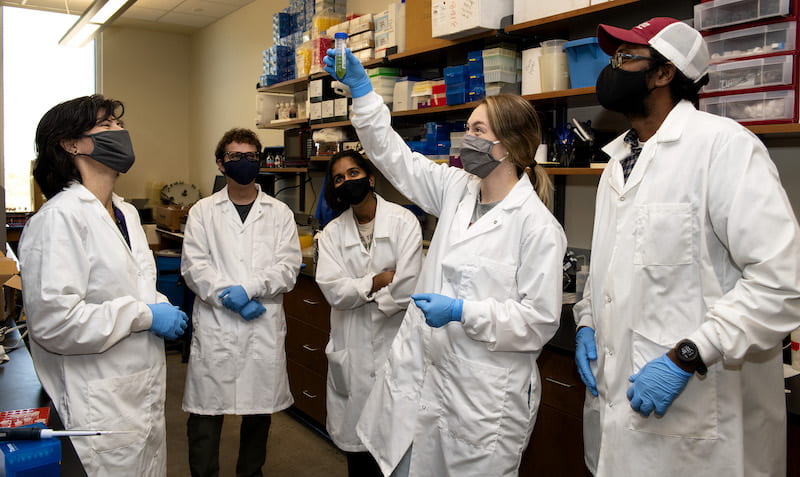Can Ruminant Ranchers Control Nitrogen Loss with a Special Feed?

The Problem
Reactive nitrogen loss — in grazing animals, in the ground, and in the atmosphere — is a potential area for reducing the environmental footprint of livestock production, according to a five-year USDA Agricultural Research Service study.
Nitrogen loss in ruminants like cattle and sheep is not just a loss for farm profit but can contribute to air and water pollution when it is not retained in the soil, said Mary Savin, professor of soil biology and microbial ecology with the Arkansas Agricultural Experiment Station, the research arm of the University of Arkansas System Division of Agriculture.
Previous studies have shown that tannins generally slow decomposition and nitrogen mineralization, or the breakdown of compounds and release of nitrogen by the action of microorganisms (Handyyanto, Cadisch and Giller, 1997; Kraus et al., 2003). Tannins are a group of polyphenolic compounds that bind with proteins like nitrogen and are present in many plants that livestock consume, Savin said.
In 2018, Savin and Division of Agriculture animal science colleagues Ken Coffey, Dirk Philipp and Jiangchao Zhao began a study supported by the USDA-National Institute of Food and Agriculture and Agriculture and Food Research Initiative that investigates the impacts of alternative forage diets on ruminant production and the fate of nitrogen in the environment. Researchers testing varying levels of tannins intended to bind nitrogen in the animal’s system and create a slower-release form of nitrogen excreted in animal waste.
The study seeks to improve the management of animal production systems to simultaneously benefit animal health as well as carbon and nitrogen cycling in pastures. The goal is to reduce environmental impact and enhance overall production sustainability by maximizing nitrogen retention in the animal as well as nitrogen retention in the soil after receiving animal waste, Savin writes.
The Work
To evaluate an optimal diet, experiment station researchers fed ruminants alfalfa silage diets with different proportions of naturally occurring phytochemicals as tannins (0, 1.5, 3.0, or 4.5 percent). The diets in their first experiment contained Sericea lespedeza, a perennial legume that has been shown to reduce parasite loads in sheep and goats. In a subsequent experiment, Lablab purpureus was included in the ruminant diet. Lablab purpureus is known as field bean or Egyptian bean. In other experiments, ruminant feed included grasses combined with tannin-containing supplements.
Soil nitrogen lost through volatilization of gases and nitrogen losses from leaching down below roots were measured for 42 days to gauge nitrogen retained versus nitrogen lost as greenhouse gases and ammonia emissions or lost with draining water. Plots receiving urine treatments served as positive control while unamended plots served as the negative control.
As a co-principal investigator in the study, Zhao is working with animal science graduate student Jianmin Chai on microbiome analysis. They are assessing the contribution of the microbial community in the soil to the fate of nitrogen processing with DNA sequencing technology.

The Results
Increasing the percentage of polyphenolic compounds in the animal diet did not result in a trend of increasing or decreasing concentrations in soil or leachate nitrogen in either of the first two experiments. Leachate is water that has percolated through a solid and leached out some of the constituents.
Savin’s report noted that carbon dioxide and ammonia emissions were high initially across all treatments in experiments carried out in the late fall and during the spring. Of the nitrogen lost as ammonia, 59 to 84 percent of the emissions occurred in the first three days after application. Initial carbon dioxide and ammonia emissions then decreased rapidly and remained low throughout the 42-day experiment. In contrast, nitrous oxide emissions were low throughout the experiment in the late fall. In both experiments, ammonium concentrations were highest at the surface level, 0-to-2-inch soil depth, compared to the soil level deeper than 2 inches.
For the experiment that took place in the late fall and early winter, emissions rose on the day of application of urine and manure from a background level of 180 milligrams of carbon as carbon dioxide (CO2) per square meter per hour to 670 milligrams per square meter per hour. With applications of animal waste as nutrients, emissions rose from the background to a range of 1,120 to 2,070 milligrams of carbon as CO2 per square meter per hour. The low temperatures and drier conditions did limit microbial activity after the initial flush of carbon dioxide. However, the losses in ammonia remained as great as at any other time of year.
As temperatures decrease, microbial activity in the soil also decreases, but there is still nitrogen loss as ammonia volatilization under colder temperatures because of biochemical (e.g., enzyme) activity in the soil, Savin explained.
“One might expect greater loss with warmer temperatures,” Savin said. “However, the question is whether under colder air temperatures and lack of active aboveground plant growth, ‘Does the residual biochemical activity in the soil and the microorganisms that are still active respond to inputs, and result in greater nitrogen losses? Conversely, does soil actually retain more nitrogen from the inputs of the ruminants fed the modified legume-based diet?’”
Results obtained in the spring demonstrate the importance of rain filling up and draining soil pores because it promotes healthy microbial communities and activity, she added.
During the spring, the loss of applied nitrogen as ammonia ranged from 14 to 24 percent in the animal waste applications, similar to applications occurring in the late-fall experiment. The researchers measured applied nitrogen losses as ammonia between 15 and 34 percent in the colder months. There were also “significant differences” between the negative control and particular treatments in soil and leachate nitrogen at different time points in the warmer and wetter spring, Savin added. Less ammonium and nitrate were measured in soil receiving manure compared to urine treatments, Savin’s report added. In the spring, nitrous oxide released from soil ranged from 0.22 to 0.36 percent in manure treatments to 1.9 to 2.9 percent in urine treatments.
Savin said Coffey’s lab found variable concentrations of hippuric acid, a breakdown product of tannin, in the urine of animals that did not correspond to the initial diet treatments. Variable breakdown of the tannins during digestion may explain the lack of clear diet treatment effects of tannins on the fate of nitrogen in the animal and in the environment, Savin explained.
Over the winter of 2021 and spring of 2022, Savin and her research team are focusing on applications of treatments to soil based on hippuric acid concentrations in urine rather than the tannin levels because of the variable breakdown of tannins found among individual animals.

Students learn how to conduct microbial ecology and soil biology experiments in Mary Savin’s lab. The professor is a member of the University of Arkansas Teaching Academy and a Qualified Environmental Professional, certified through the Institute of Professional Environmental Practice.
The Value
The first two experiments in this study found that dietary supplementation with tannins in ruminant feed did not affect gas emissions from soil. The last experiment will measure hippuric acid levels from increasing polyphenolic compounds, instead of just tannin levels, and is expected to provide better data on diet treatment impacts on nitrogen retention in ruminant waste in the soil.
Determining methods to retain nitrogen in the soil and minimize loss to the atmosphere remains a valuable agricultural goal for soil health and air quality. The results of this study will help contribute to the growing body of knowledge about the environmental footprint of livestock production. Even in the colder months, when there is less microbial activity in the soil, the study found comparable rates of applied nitrogen losses as ammonia gas as compared to the warmer, wetter months.
About the Researcher

Mary Savin
Professor of Microbial Ecology
Dept. of Crop, Soil and Environmental Sciences
- B.S. in biology from the University of Notre Dame
- M.S. in natural resources from the University of Rhode Island
- Ph.D. in biological sciences from the University of Rhode Island
Dr. Savin is professor of Microbial Ecology and Soil Biology and researches the microbial ecology of both terrestrial and aquatic ecosystems. She is a Qualified Environmental Professional, certified through the Institute of Professional Environmental Practice. Savin is a member of the University of Arkansas Teaching Academy and former co-director of the U of A Wally Cordes Teaching and Faculty Support Center

Ken Coffey
Professor of Animal Science
Dept. of Animal Science
- B.S. in animal science from the University of Tennessee
- M.S. from the University of Kentucky
- Ph.D. from the University of Missouri with a research emphasis on ruminant nutrition.
Dr. Coffey’s research focuses on optimizing the production and economic efficiency of livestock by consuming forages that are either prevalent or have the potential to become prevalent in Arkansas. He also focuses on evaluating methods of improving forage utilization by ruminants.

Dirk Philipp
Associate Professor of Animal Science
Dept. of Animal Science
- M.S. in tropical agriculture from the University of Leipzig in Germany
- Ph.D. In agronomy from Texas Tech University
Dr. Philipp designs and implements research programs related to forage utilization and grazing management for increased profitability and environmental quality, especially in the nutrient-surplus areas of Northwest Arkansas.

Jiangchao Zhao
Associate Professor of Animal Science
Dept. of Animal Science
- B.S. in plant pathology from China Agricultural University in Beijing
- Ph.D. in environmental microbiology from the University of Wisconsin – Madison
Dr. Zhao’s scientific research has focused on human and animal microbiomes.




